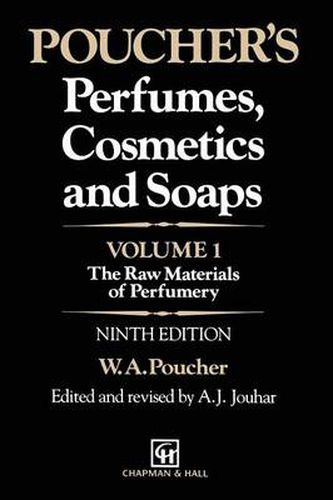Readings Newsletter
Become a Readings Member to make your shopping experience even easier.
Sign in or sign up for free!
You’re not far away from qualifying for FREE standard shipping within Australia
You’ve qualified for FREE standard shipping within Australia
The cart is loading…






This title is printed to order. This book may have been self-published. If so, we cannot guarantee the quality of the content. In the main most books will have gone through the editing process however some may not. We therefore suggest that you be aware of this before ordering this book. If in doubt check either the author or publisher’s details as we are unable to accept any returns unless they are faulty. Please contact us if you have any questions.
This classic work by Poucher, first published in 1923, was last produced in three volumes titled, respectively The Raw Materials of Perfumery (seventh edition, 1974), The Production, Manufacture and Application of Perfumes (eighth edition, 1974) and Modern Cosmetics (eighth edition, 1974). Its popularity is well demonstrated by there having been three reprints of these editions in 1976, 1979 and 1984, respectively. The history of events can be traced by reference to the prefaces to earlier editions and those interested should study these with care since they give a fascinating insight into developments in the subject fields covered by Poucher’s Perfumes, Cosmetics and Soaps over the years. It is not proposed to provide a resume here. In this Volume I, the current edition attempts to provide data about raw materials in a more formalized way than before, so that not only the history of some compounds can be checked, but also so that useful reference information can be obtained. It is particularly relevant to do this, since it is not always easy to be certain of nomenclature. Moreover, as we move towards ‘ingredient labelling’ (a trend not welcomed by some), a high level of uniformity will be needed. Whether this will come from adoption of CTFA terminology, use of CAS numbers or some other system is not clear. Where possible, such data have been included so that readers may identify materials more readily. Where given, CAS numbers are located in the top right-hand corner of each entry.
$9.00 standard shipping within Australia
FREE standard shipping within Australia for orders over $100.00
Express & International shipping calculated at checkout
This title is printed to order. This book may have been self-published. If so, we cannot guarantee the quality of the content. In the main most books will have gone through the editing process however some may not. We therefore suggest that you be aware of this before ordering this book. If in doubt check either the author or publisher’s details as we are unable to accept any returns unless they are faulty. Please contact us if you have any questions.
This classic work by Poucher, first published in 1923, was last produced in three volumes titled, respectively The Raw Materials of Perfumery (seventh edition, 1974), The Production, Manufacture and Application of Perfumes (eighth edition, 1974) and Modern Cosmetics (eighth edition, 1974). Its popularity is well demonstrated by there having been three reprints of these editions in 1976, 1979 and 1984, respectively. The history of events can be traced by reference to the prefaces to earlier editions and those interested should study these with care since they give a fascinating insight into developments in the subject fields covered by Poucher’s Perfumes, Cosmetics and Soaps over the years. It is not proposed to provide a resume here. In this Volume I, the current edition attempts to provide data about raw materials in a more formalized way than before, so that not only the history of some compounds can be checked, but also so that useful reference information can be obtained. It is particularly relevant to do this, since it is not always easy to be certain of nomenclature. Moreover, as we move towards ‘ingredient labelling’ (a trend not welcomed by some), a high level of uniformity will be needed. Whether this will come from adoption of CTFA terminology, use of CAS numbers or some other system is not clear. Where possible, such data have been included so that readers may identify materials more readily. Where given, CAS numbers are located in the top right-hand corner of each entry.